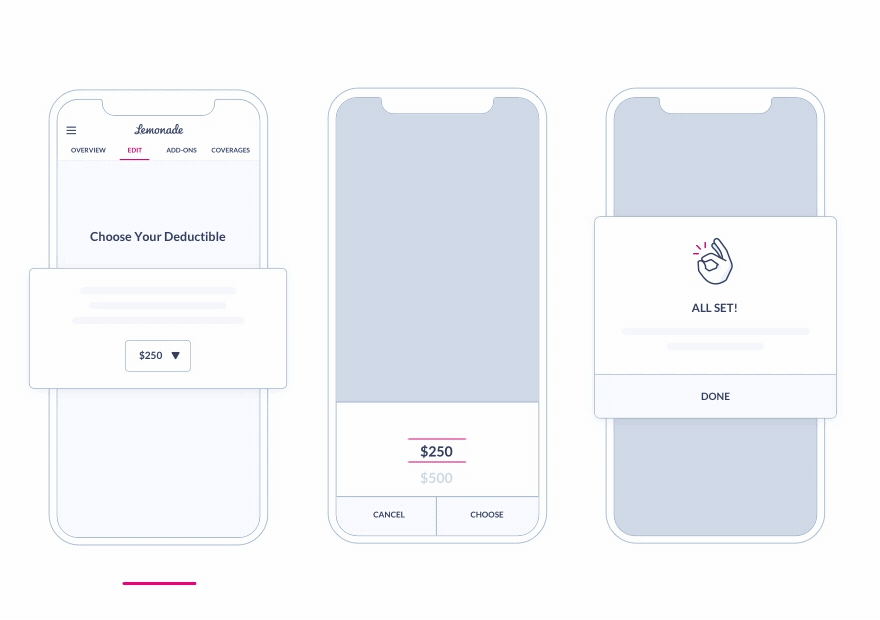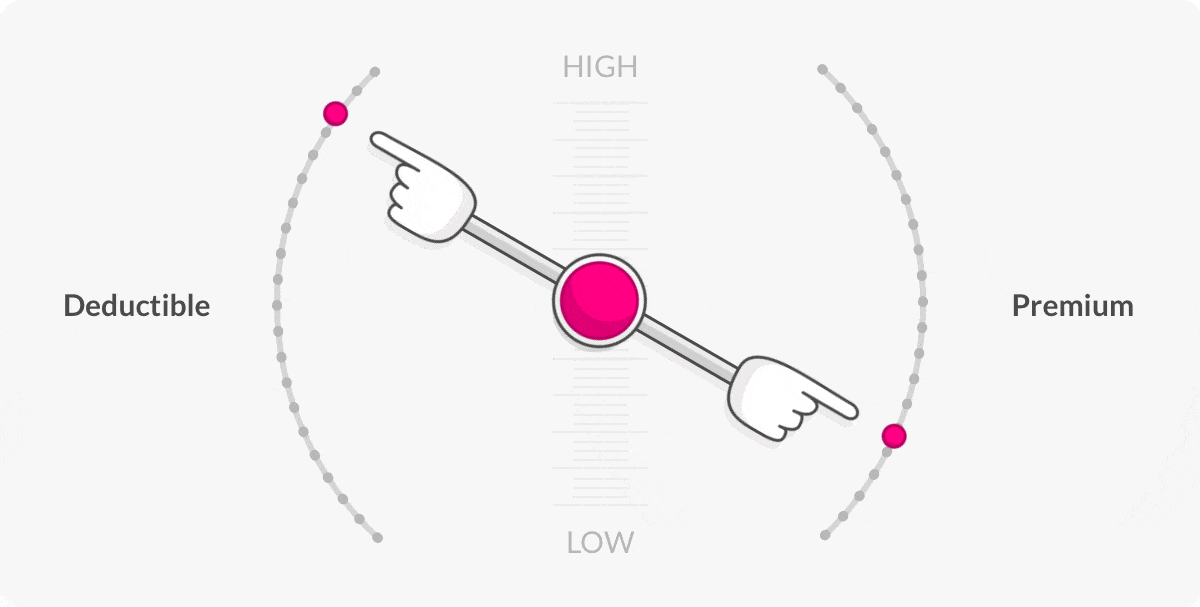What is a Homeowners Insurance Deductible?
Everything you need to know about homeowners insurance deductibles and choosing the right amount for your budget.

Everything you need to know about homeowners insurance deductibles and choosing the right amount for your budget.

A homeowners insurance deductible is the amount you pay out of pocket before your insurance company covers eligible claims for damage to your home and belongings. It’s a key part of how home insurance works; you meet your deductible first, then your insurance kicks in to cover the remaining costs. Just to be clear: you never pay your deductible directly to us, it’s either paid to contractors or deducted from your claim settlement.
Understanding deductibles helps you better tailor your homeowners insurance for your budget and your home’s needs. Let’s break down everything homeowners need to know.
Most home insurance policies have two main types of deductibles: Fixed rate and percentage based.
The dollar amount on your policy you picked when you bought your home insurance. This is the $500 to $10,000 deductible that you pay out-of-pocket before your insurance pays on a covered claim. This standard deductible stays the same, no matter the cost of the damages to your home.
Based on a percentage of your home’s insured value. These deductibles normally apply to specific claims like wind, hail, or hurricanes. Percentage deductibles differ between companies but are typically between 1% and 10% of your home’s dwelling coverage in the policy.
Let’s say your home is insured for $400,000 and you have a 2% wind deductible, you’d pay $8,000 out-of-pocket for wind damage.
| Event type | Typical range |
|---|---|
| Wind/hail | 1-5% of dwelling coverage |
| Hurricane/named storms | 2-10% of dwelling coverage |
| Earthquake | 5-15% of coverage amount |
Homeowners insurance claims for damaged property and stolen items typically have a deductible. Your insurance company only pays for covered losses above your policy’s stated deductible.
Example: A kitchen fire causes $5,000 in damage to your home and belongings. Your deductible is $1,000. If your claim gets approved, your insurer pays you $4,000.
A homeowners insurance policy usually includes a deductible applicable to the following coverages:
At Lemonade, each coverage type has its own deductible that needs to be met before we can pay claims.

1. Report your claim: Contact Lemonade right away through our app or website. The sooner you report it, the faster we can help.
2. Document the damage: Take photos of the damage and make a list of damaged or stolen items. Keep receipts for any immediate repairs you need to make.
3. Meet with an adjuster (if needed): For larger claims, we might send someone to inspect the damage in person. For smaller, straightforward claims, photos often do the trick.
4. Get your settlement: Once we approve your claim, we’ll send you a check for the covered amount minus your deductible.
5. Make repairs: Use your settlement money to fix or replace what was damaged. You’re in charge of hiring contractors and managing the repairs.
Pro tip: You meet your deductible per claim, not per year. So if you have separate incidents, like a break-in in spring and storm damage in fall, you’d meet your deductible for each claim.
Your homeowners insurance deductible doesn’t apply in these situations:
Liability claims: If someone gets injured on your property and you’re found liable, your deductible doesn’t apply to medical bills or legal costs. Your liability coverage kicks in immediately.
Additional living expenses (ALE): If your home becomes uninhabitable due to covered damage, your ALE coverage for temporary housing and meals may not require meeting your deductible first, but this varies by state. In most states, your standard deductible applies to ALE claims.
Extra Coverage: At Lemonade, if you add Extra Coverage for things like jewelry, bicycles, cameras, fine art, or musical instruments, these claims have a zero deductible, we cover them at 100%. This special coverage also protects against things your base policy doesn’t, like mysterious loss and accidental damage.

Choosing the right deductible amount depends on your budget and financial situation. The key is balancing what you can afford to pay upfront against your monthly insurance premium.
Go with a lower deductible if you don’t have much in emergency savings or just prefer knowing exactly what you’ll pay each month when unexpected covered events happen.
Pick a higher deductible if you’ve got a solid emergency fund (6+ months of expenses saved up), want to keep your monthly premiums as low as possible, or can handle a bigger unexpected expense without it affecting your finances.
Ask yourself: “What’s the largest amount I could pay tomorrow without borrowing money or causing financial stress?” That’s likely your ideal deductible ceiling.
Understanding how homeowners insurance deductibles work is crucial for making smart decisions about your coverage and managing your home-related finances.
Remember, the goal isn’t just finding the lowest deductible – it’s finding the sweet spot that fits your financial situation when protecting your home. A well-chosen deductible can save you hundreds of dollars annually on premiums while still providing meaningful protection against major losses. Ready to see how much you could save with the right deductible for your situation?
No, for personal residences. Homeowners insurance premiums are generally not tax deductible for your primary residence. However, exceptions include:
Always consult a tax professional for your specific situation.
You pay the full repair cost yourself. If storm damage costs $800 to fix but your deductible is $1,500, your insurance pays nothing. You cover the entire repair bill. This is why it’s important to choose a deductible you can afford multiple times per year.
Yes, and you need to meet your deductible for each covered claim. Unlike health insurance, homeowners insurance deductibles apply per claim, not per year. If you have three separate incidents requiring $3,000 each in repairs, and your deductible is $1,000, you’ll pay $1,000 three times ($3,000 total).
Your deductible is what you meet first, your coverage limit is the max we’ll pay. Your deductible is the amount you pay out-of-pocket before insurance kicks in, think of it as your contribution to every claim. Your insurance coverage limit is the maximum amount your insurance will pay for covered losses.
A few quick words, because we <3 our lawyers: This post is general in nature, and any statement in it doesn’t alter the terms, conditions, exclusions, or limitations of policies issued by Lemonade, which differ according to your state of residence. You’re encouraged to discuss your specific circumstances with your own professional advisors. The purpose of this post is merely to provide you with info and insights you can use to make such discussions more productive! Naturally, all comments by, or references to, third parties represent their own views, and Lemonade assumes no responsibility for them. Coverage and discounts may not be available in all states.
Please note: Lemonade articles and other editorial content are meant for educational purposes only, and should not be relied upon instead of professional legal, insurance or financial advice. The content of these educational articles does not alter the terms, conditions, exclusions, or limitations of policies issued by Lemonade, which differ according to your state of residence. While we regularly review previously published content to ensure it is accurate and up-to-date, there may be instances in which legal conditions or policy details have changed since publication. Any hypothetical examples used in Lemonade editorial content are purely expositional. Hypothetical examples do not alter or bind Lemonade to any application of your insurance policy to the particular facts and circumstances of any actual claim.